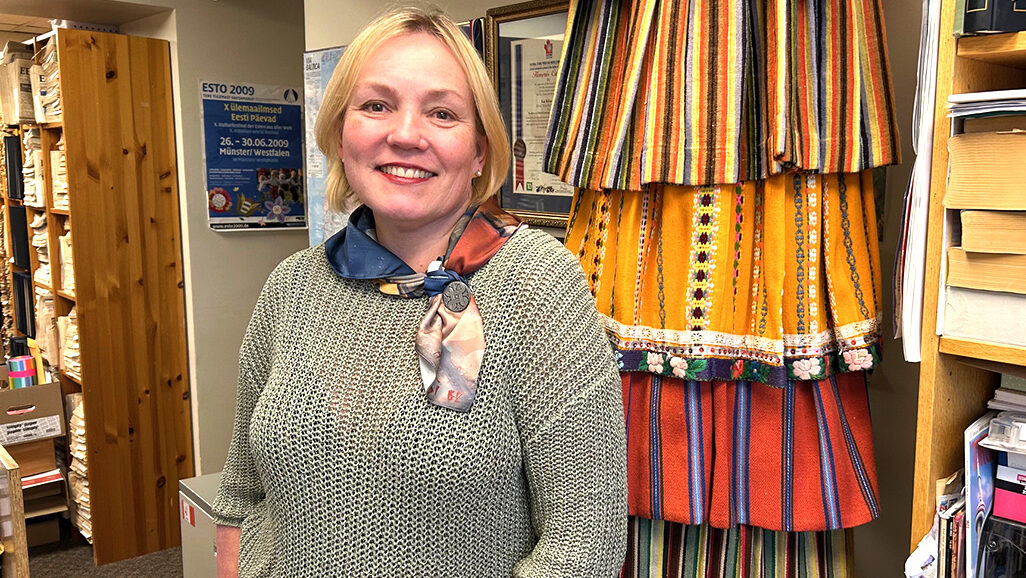

At this year’s Estonian Music Week, we have the chance to immerse ourselves not only in live music, but also in interactive visual art. At Estonian Foundation of Canada Presents: The Art Party, the audience is invited to explore and express their identity with Society of Estonian Artists in Toronto’s collaborative art experiment, experience a sound and light installation by Constellation Creative featuring Shawn Rompré, Yasmine Shelton, and Steve Nillo, absorb artwork by Riivo, and participate in a weaving workshop with Veinika Västrik.
You will also be able to discover the beautiful and iconic fashion of the Seto region of Estonia through Women with Headcovers, an exhibition which is being sponsored by Humphrey Funeral Home. Each region of Estonia in fact has its own colour schemes and patterns displayed in folk art and handicraft. Art and handicraft have been a vital form of Estonian expression, a way to connect the community and share amongst each other. Let us take this time to remember the following two people from our Estonian-Canadian community whose passion and talent were essential in keeping the Estonian spirit alive and nurturing our community through art.

Ene Runge
Ene Runge was born in 1919 in the municipality of Meeri in Tartu County, Estonia. She first developed her love of Estonian handicraft in the family home. This passion drove her to be a champion of Estonian folk art while living in Canada. In October 1971, she was one of the organizers of an exhibition about Estonian folk costumes at the Estonian House in Toronto. There, Runge asked the public if there was any interest in establishing a group dedicated to collecting and creating Estonian folk art. This resulted in the founding of the Estonian Ethnographic Society in Canada in November of the same year. Ene Runge became director of this society in 1974, and under her leadership brought significant exposure to Estonian folk art. For the ESTO ’84 festival, the Society arranged three exhibitions, which took place at the Estonian House, Royal York Hotel, as well as the Royal Ontario Museum. Visitors to the ROM were able to see and learn about Estonian folk art and handicraft. The exhibition was supposed to be open for just one month, though due to its popularity, it stayed open for four and a half months. Under Runge’s direction, the Estonian Ethnographic Society in Canada was able to help the ROM establish a collection of Estonian folk art and handicraft. Her influence is felt outside of Canada as well – she assisted in establishing ethnographic societies in Sweden and Australia. Ene Runge passed away in 1999 in Toronto, and in addition to her legacy of championing folk art, pieces she had created herself can be found in VEMU Estonian Museum Canada’s collections, which include tapestry and articles of Estonian folk costumes.

Endel Ruberg
Endel Ruberg was born in 1917 in Sõmeru in Viru County, Estonia. Although he studied art in Helsinki, Finland, he had to put his passion aside to serve in the military during World War II. As the occupiers unfortunately won, Ruberg first fled to Sweden, and went on from there to settle in Montreal, Canada. During this time, he was actively working on his art and handicraft. Ruberg worked with various artistic mediums including leather and watercolour, and discovered a unique frozen watercolour technique, which had the watercolour freeze as applied to the paper to create interesting shapes and textures.
As an active member of the Estonian community, he shared his artistic techniques first with the Montreal Estonian youth, and then also began offering courses elsewhere. This included the Toronto Estonian youth with classes at the Toronto Estonian House, or to the residents of Eesti Kodu, members of the Montreal Estonian Pensioners Club, and of course to the youth attending Estonian summer camps. His work was not only known in the Estonian community, but in the Canadian sphere as well, and he was a recipient of a Queen Elizabeth II medal for his contribution to Canadian art. Endel Ruberg died in Stockholm in 1989 while travelling, and he is remembered for his talent as well as for his community building and encouraging keen interest in Estonian handicraft amongst different generations.
We honour these two individuals not only for their talent, but also for everything they did to keep the Estonian spirit alive in the diaspora. Sharing and creating art is certainly a powerful way of keeping a community thriving, and Ene Runge and Endel Ruberg are two individuals who certainly proved this to be true.



